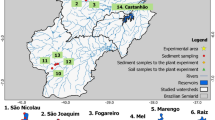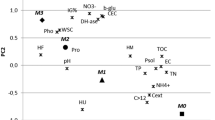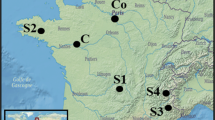Abstract
Purpose
The main results of the experience of CNR-IRET Pisa regarding sediment recovery and recycling are reported.
Methods and results
In the AGRIPORT project, saline and brackish sediments were mixed with agronomic soil and underwent phytoremediation. After two years, heavy metals and hydrocarbons decreased, and the improvement of chemical and biological properties created a “functional soil” for further applications. Both phytoremediated sediments were refined through landfarming in the CLEANSED and HORTISED projects and applied for civil and agricultural uses. The landfarming process further reduced the organic contaminants in both sediments. Then, in CLEANSED, nursery plants performed similarly in brackish sediment-based substrates as in alluvial soil (control) (33% and 50%). In HORTISED, horticultural plants, grown on substrates with peat and remediated saline sediments (50%), had a yield, number, weight, and fruit quality comparable with those grown on peat. In the “Fondazione Cassa di Risparmio di Pistoia e Pescia” project, the decontaminated saline sediments were successfully co-composted with Posidonia oceanica and reused as nursery growth substrate. Another two European LIFE projects are still in progress. The SUBSED project aims to confirm the suitability of saline-remediated sediments after landfarming as an alternative substrate to peat and coconut fiber for fruit, flowering, and non-food crops. The AGRISED project aims to recover brackish sediments through a co-composting process with green waste to produce an innovative substrate for the cultivation of ornamental plants.
Conclusions
The projects confer environmental, economic, and social values to sediments, through their eco-sustainable recovery and use in different sectors.

Similar content being viewed by others
References
Ayilara MS, Olanrewaju OS, Babalola OO, Odeyemi O (2020) Waste management through composting: challenges and potentials. Sustainability 12(11):4456
Barrett GE, Alexander PD, Robinson JS, Bragg NC (2016) Achieving environmentally sustainable growing media for soilless plant cultivation systems–a review. Sci Horti 212:220–234. https://doi.org/10.1016/j.scienta.2016.09.030
Cesaro A, Belgiorno V, Guida M (2015) Compost from organic solid waste: Quality assessment and European regulations for its sustainable use. Resour Conserv Recy 94:72–79. https://doi.org/10.1016/j.resconrec.2014.11.003
Chhabra R (2004) Classification of salt-affected soils. Arid Land Res Manag 19(1):61–79. https://doi.org/10.1080/15324980590887344
Doni S, Macci C, Peruzzi E, Iannelli R, Ceccanti B, Masciandaro G (2013) Decontamination and functional reclamation of dredged brackish sediments. Biodegradation 24(4):499–512. https://doi.org/10.1007/s10532-012-9606-1
EU (2008) Directive 2008/98/EC of the European Parliament and of the Council of 19 November 2008 on waste and repealing certain Directives (Text with EEA relevance)
EU (2019) Regulation 2019/1009 of the European Parliament and of the Council of 5 June 2019, laying down rules on the making available on the market of EU fertilising products and amending. Regulations (EC) No 1069/2009 and (EC) No 1107/2009 and repealing Regulation (EC) No 2003/2003
Gavilanes-Terán I, Jara-Samaniego J, Idrovo-Novillo J, Bustamante MA, Moral R, Paredes C (2016) Windrow composting as horticultural waste management strategy–a case study in Ecuador. Waste Manage 48:127–134. https://doi.org/10.1016/j.wasman.2015.11.026
Guo XX, Liu HT, Wu SB (2019) Humic substances developed during organic waste composting: Formation mechanisms, structural properties, and agronomic functions. Sci Total Environ 662:501–510. https://doi.org/10.1016/j.scitotenv.2019.01.137
Hoekstra NJ, Bosker T, Lantinga EA (2002) Effects of cattle dung from farms with different feeding strategies on germination and initial root growth of cress (Lepidium sativum L.). Agric Ecosyst Environ 93(1–3):189–196. https://doi.org/10.1016/S0167-8809(01)00348-6
ISO (1994) ISO 11260: Soil quality — determination of effective cation exchange capacity and base saturation level using barium chloride solution. International Organization for Standards (ISO), Geneva, Switzerland
ISO (2017) ISO 11272: Soil quality — determination of dry bulk density. International Organization for Standards (ISO), Geneva, Switzerland
Jurado MM, Suárez-Estrella F, Vargas-García MC, López MJ, López-González JA, Moreno J (2014) Evolution of enzymatic activities and carbon fractions throughout composting of plant waste. J Environ Manage 133:355–364. https://doi.org/10.1016/j.jenvman.2013.12.020
Macci C, Peruzzi E, Doni S, Vannucchi F, Masciandaro G (2021) Landfarming as a sustainable management strategy for fresh and phytoremediated sediment. Environ Sci Pollut Res 28:39692–39707. https://doi.org/10.1007/s11356-021-13134-y
Martínez-Nicolás JJ, Legua P, Hernández F, Martínez-Font R, Giordani E, Melgarejo P (2021) Effect of phytoremediated port sediment as an agricultural medium for pomegranate cultivation: mobility of contaminants in the plant. Sustainability 13:9661. https://doi.org/10.3390/su13179661
Marx MC, Wood M, Jarvis SC (2001) A microplate fluorimetric assay for the study of enzyme diversity in soils. Soil Biol Biochem 33(12–13):1633–1640. https://doi.org/10.1016/S0038-0717(01)00079-7
Masciandaro G, Di Biase A, Macci C, Peruzzi E, Iannelli R, Doni S (2014) Phytoremediation of dredged marine sediment: monitoring of chemical and biochemical processes contributing to sediment reclamation. J Environ Manage 134:166–74. https://doi.org/10.1016/j.jenvman.2013.12.028
Mattei P, D’Acqui LP, Nicese FP, Lazzerini G, Masciandaro G, Macci C, Doni S, Sarteschi F, Giagnoni L, Renella G (2017) Use of phytoremediated sediments dredged in maritime port as plant nursery growing media. J Environ Manage 186:225–232. https://doi.org/10.1016/j.jenvman.2016.05.069
Onwosi CO, Igbokwe VC, Odimba JN, Eke IE, Nwankwoala MO, Iroh IN, Ezeogu LI (2017) Composting technology in waste stabilization: on the methods, challenges and future prospects. J Environ Manage 190:140–157. https://doi.org/10.1016/j.jenvman.2016.12.051
Peruzzi E, Macci C, Doni S, Longo V, Souid A, Ugolini F, Zelari L, Masciandaro G (2021) Posidonia oceanica based-compost and dredged sediments as a growth substrate for ornamental plants. Acta Hortic 1305:317–324. https://doi.org/10.17660/ActaHortic.2021.1305.43
Peruzzi E, Macci C, Doni S, Zelari L, Masciandaro G (2020) Co-composting as a management strategy for Posidonia oceanica residues and dredged sediments. Waste Biomass Valori 11(9):4907–4919. https://doi.org/10.1007/s12649-019-00822-7
Tozzi F, Del Bubba M, Petrucci WA, Pecchioli S, Macci C, García FH, Nicolás JJM, Giordani E (2020) Use of a remediated dredged marine sediment as a substrate for food crop cultivation: sediment characterization and assessment of fruit safety and quality using strawberry (Fragaria x ananassa Duch.) as model species of contamination transfer. Chemosphere 238:124651. https://doi.org/10.1016/j.chemosphere.2019.124651
Tozzi F, Renella G, Cristina M, Masciandaro G, Gonnelli C, Colzi I, Giagnoni L, Pecchioli S, Nin S, Giordani E (2021) Agronomic performance and food safety of strawberry cultivated on a remediated sediment. Sci Total Environ 796:148803. https://doi.org/10.1016/j.scitotenv.2021.148803
Ugolini F, Calzolari C, Lanini GM, Massetti L, Pollaki S, Raschi A, Sabatini F, Tagliaferri G, Ungaro F, Massa D, Antonetti M, Izquierdo CG, Macci C, Masciandaro G (2017) Testing decontaminated sediments as a substrate for ornamentals in field nursery plantations. J Environ Manage 197:681–693. https://doi.org/10.1016/j.jenvman.2017.03.064
USEPA (1995) Method 3545, in pressurized fluid extraction, test methods for evaluating solid waste, update III, EPA SW-846, US GPO, Washington, DC, 3rd Eds
USEPA (1997) Method 3630. Test methods for evaluating solid waste (SW-846), update III. US Environmental Protection Agency, Office of Solid Waste and Emergency Response, Washington, DC
USEPA (2007) EPA Method 3545A. Pressurized Fluid Extraction (PFE), Test Methods for Evaluating Solid Waste
Vepsäläinen M, Kukkonen S, Vestberg M, Sirviö H, Niemi RM (2001) Application of soil enzyme activity test kit in a field experiment. Soil Biol Biochem 33(12–13):1665–1672. https://doi.org/10.1016/S0038-0717(01)00087-6
Wittmann C, Kähkönen MA, Ilvesniemi H, Kurola J, Salkinoja-Salonen MS (2004) Areal activities and stratification of hydrolytic enzymes involved in the biochemical cycles of carbon, nitrogen, sulphur and phosphorus in podsolized boreal forest soils. Soil Biol Biochem 36(3):425–433. https://doi.org/10.1016/j.soilbio.2003.10.019
Funding
This study was supported by the following projects: AGRIPORT (ECO/08/239065) Agricultural reuse of polluted dredged sediment; CLEANSED (LIFE12 ENV/IT/000652) Innovative integrated methodology for the use of decontaminated river sediments in plant nursing and road building; HORTISED (LIFE14 ENV/IT/000113) Demonstration of the suitability of dredged remediated sediment for safe and sustainable horticulture production; SUBSED (LIFE17ENV/IT/000347) Sustainable substrates for agriculture from dredged remediated marine sediments: from ports to pots; AGRISED (LIFE17 ENV/IT/269) Use of dredged sediments for creating innovative growing media and technosols for plant nursery and soil rehabilitation; “Fondazione Cassa di Risparmio di Pistoia e Pescia” in the framework “Giovani@Ricerca Scientifica 2016.”
Author information
Authors and Affiliations
Corresponding author
Ethics declarations
Competing interests
The authors declare no competing interests.
Additional information
Responsible editor: Bruno Lemière
Publisher's Note
Springer Nature remains neutral with regard to jurisdictional claims in published maps and institutional affiliations.
Rights and permissions
About this article
Cite this article
Macci, C., Vannucchi, F., Doni, S. et al. Recovery and environmental recycling of sediments: the experience of CNR-IRET Pisa. J Soils Sediments 22, 2865–2872 (2022). https://doi.org/10.1007/s11368-022-03162-7
Received:
Accepted:
Published:
Issue Date:
DOI: https://doi.org/10.1007/s11368-022-03162-7




